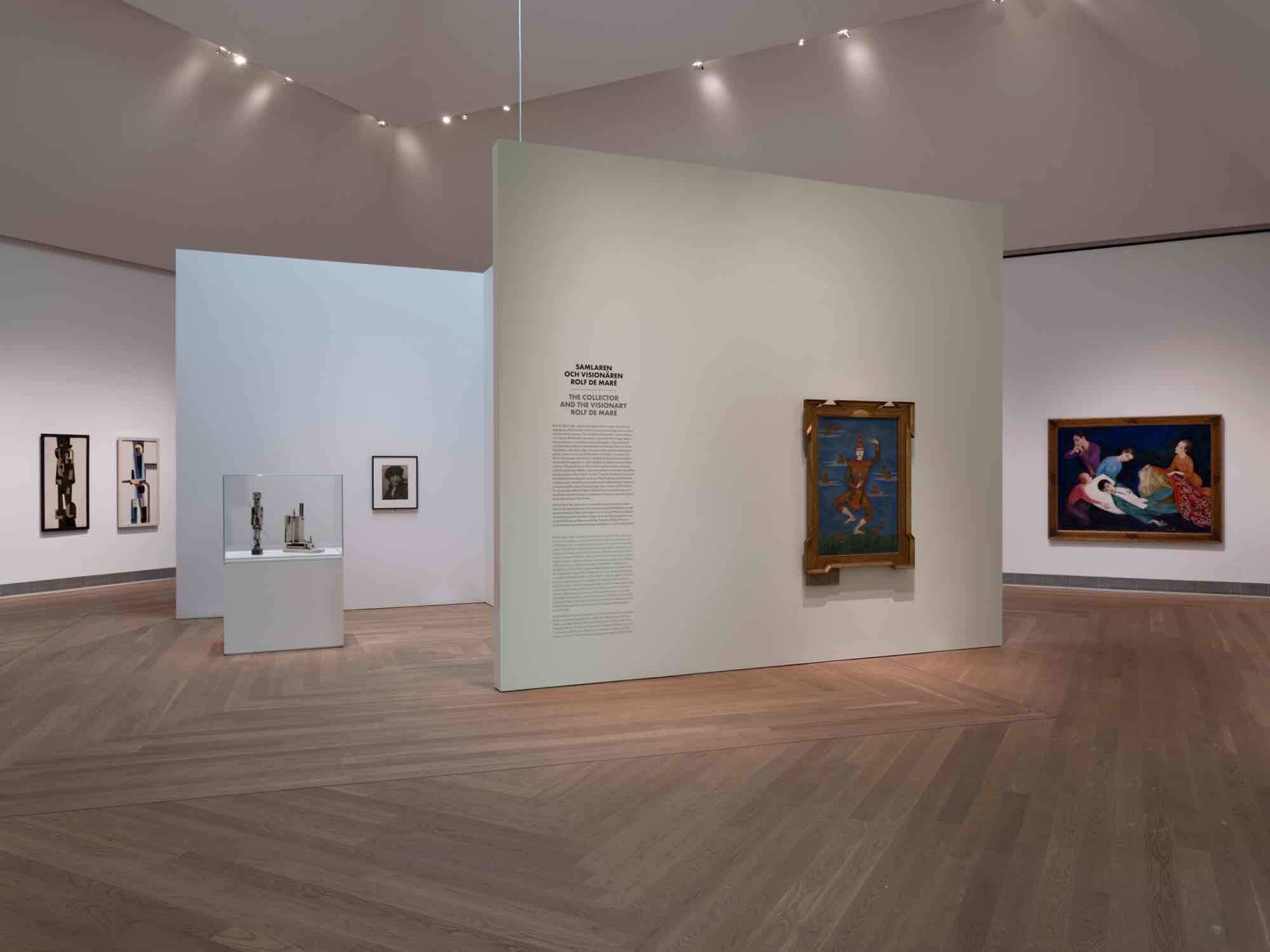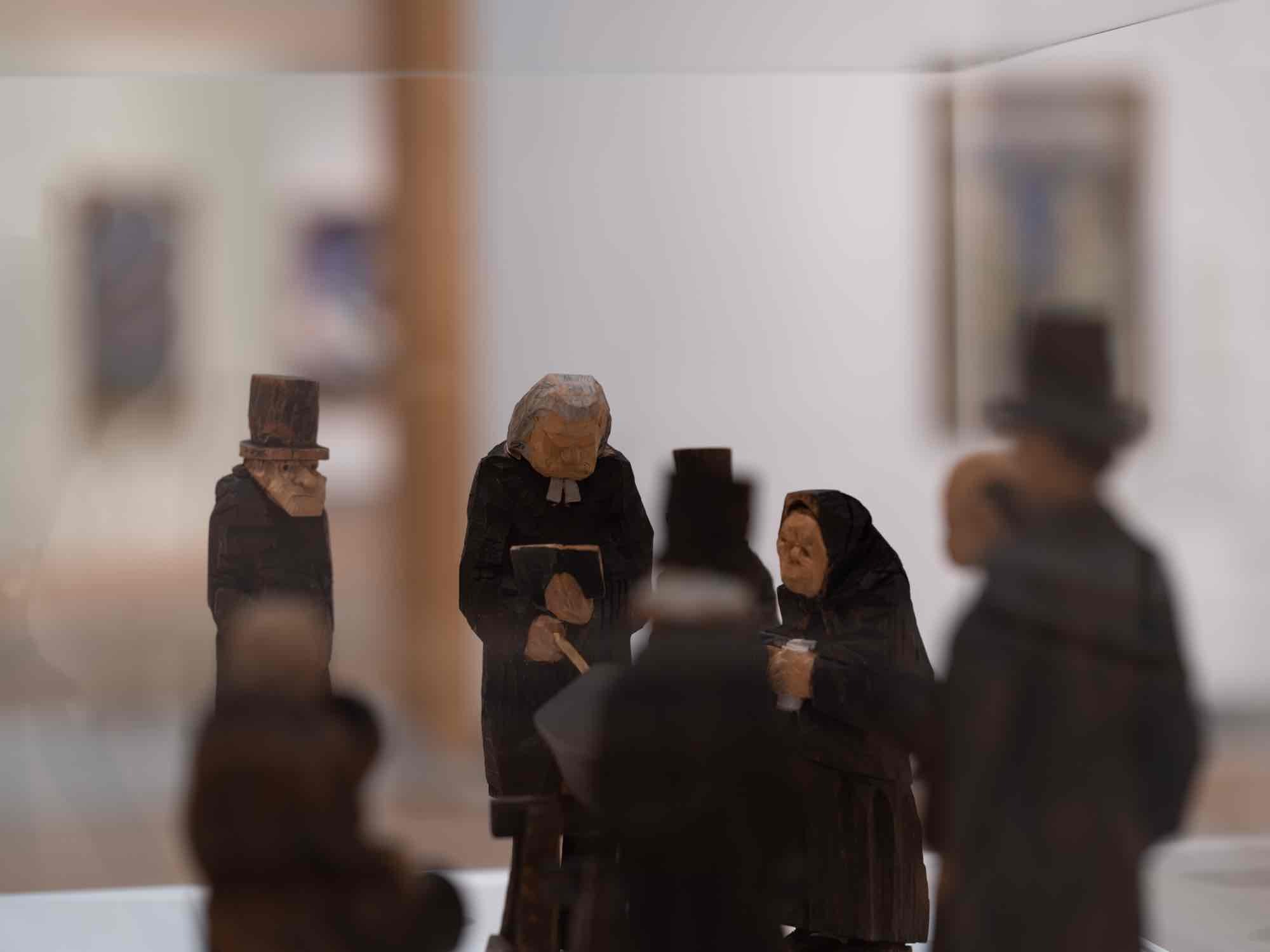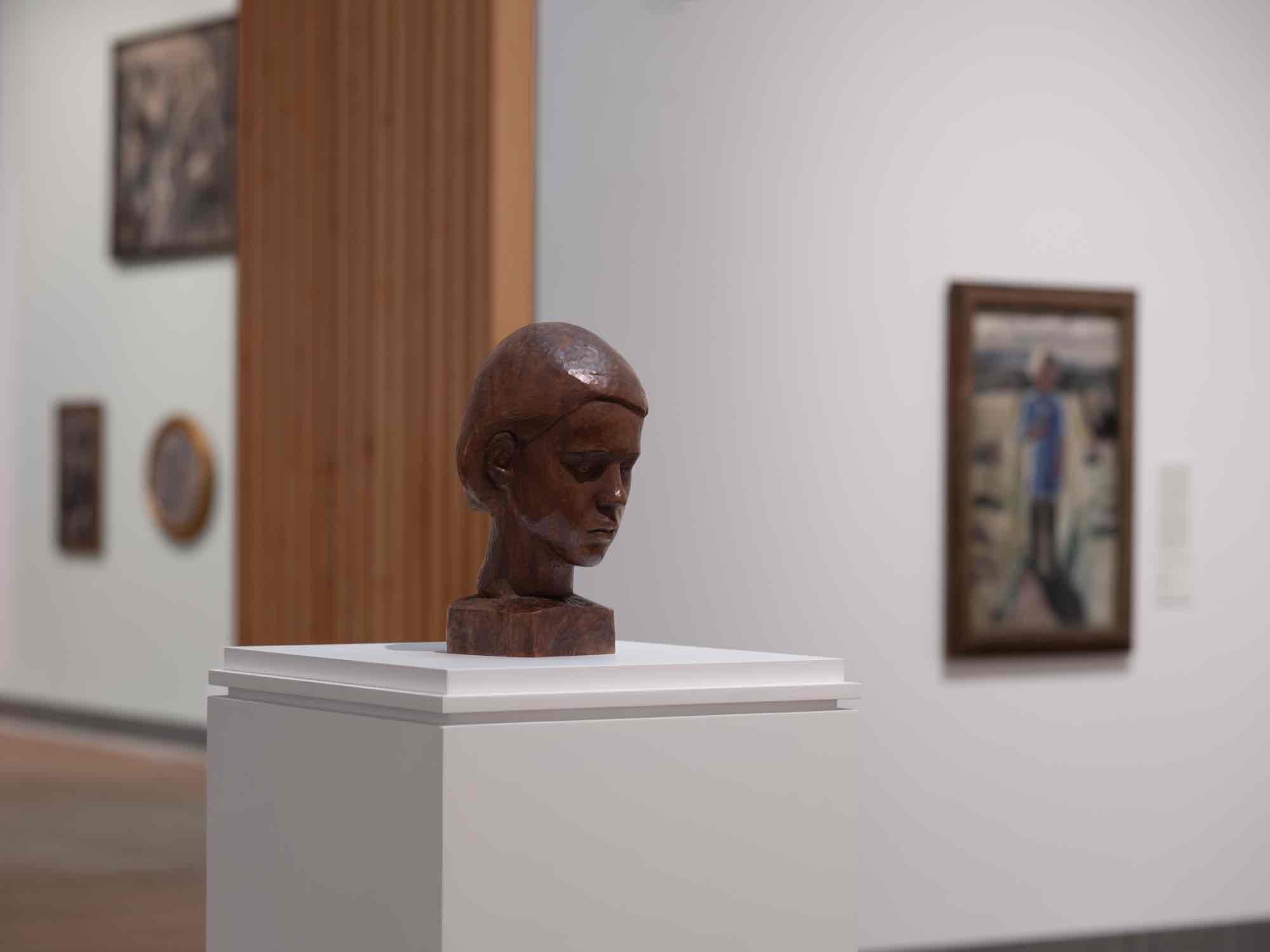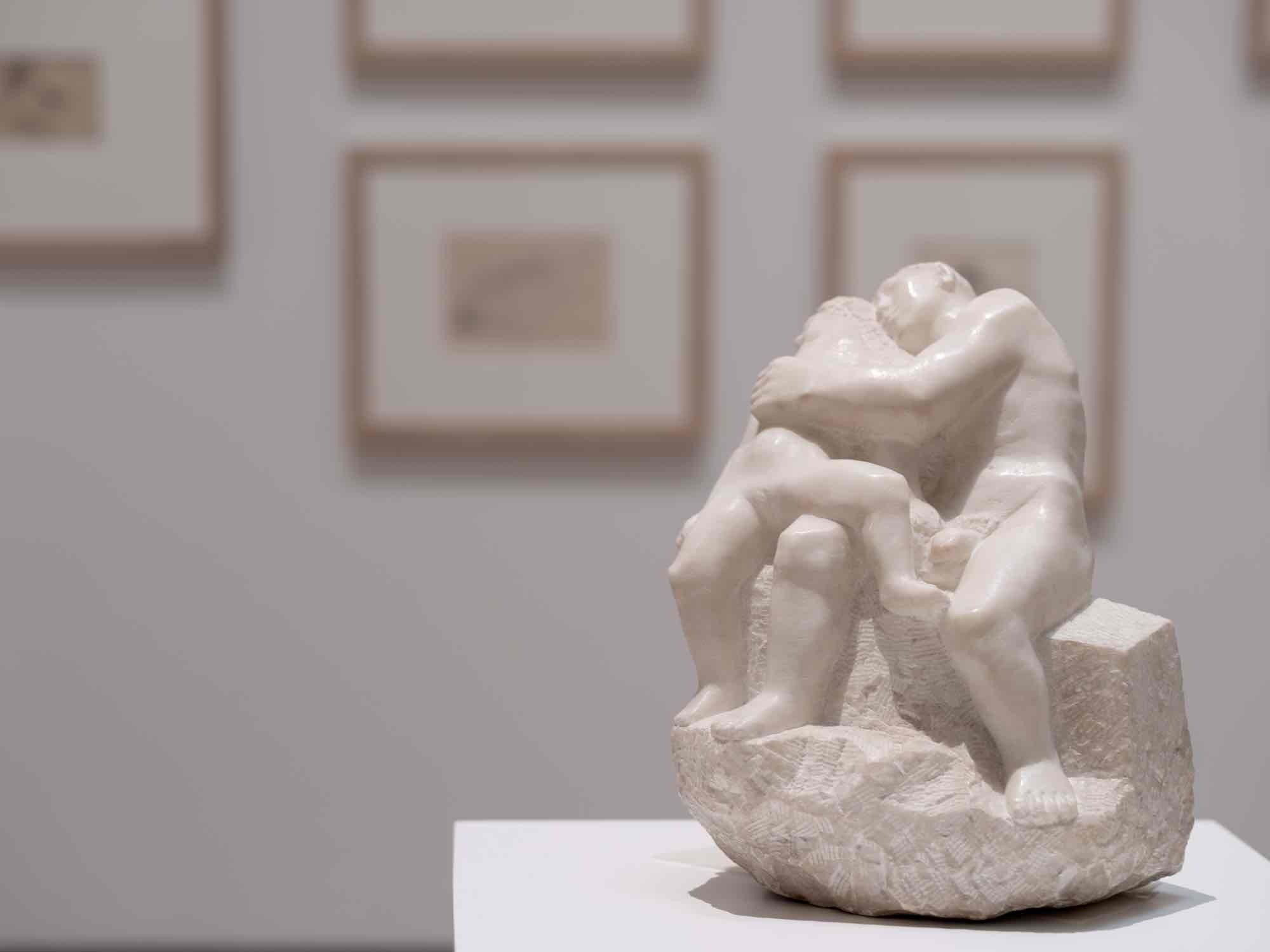Pink Sails
Swedish Modernism in the Moderna Museet Collection
17 Jun 2023 - 03 Aug 2025
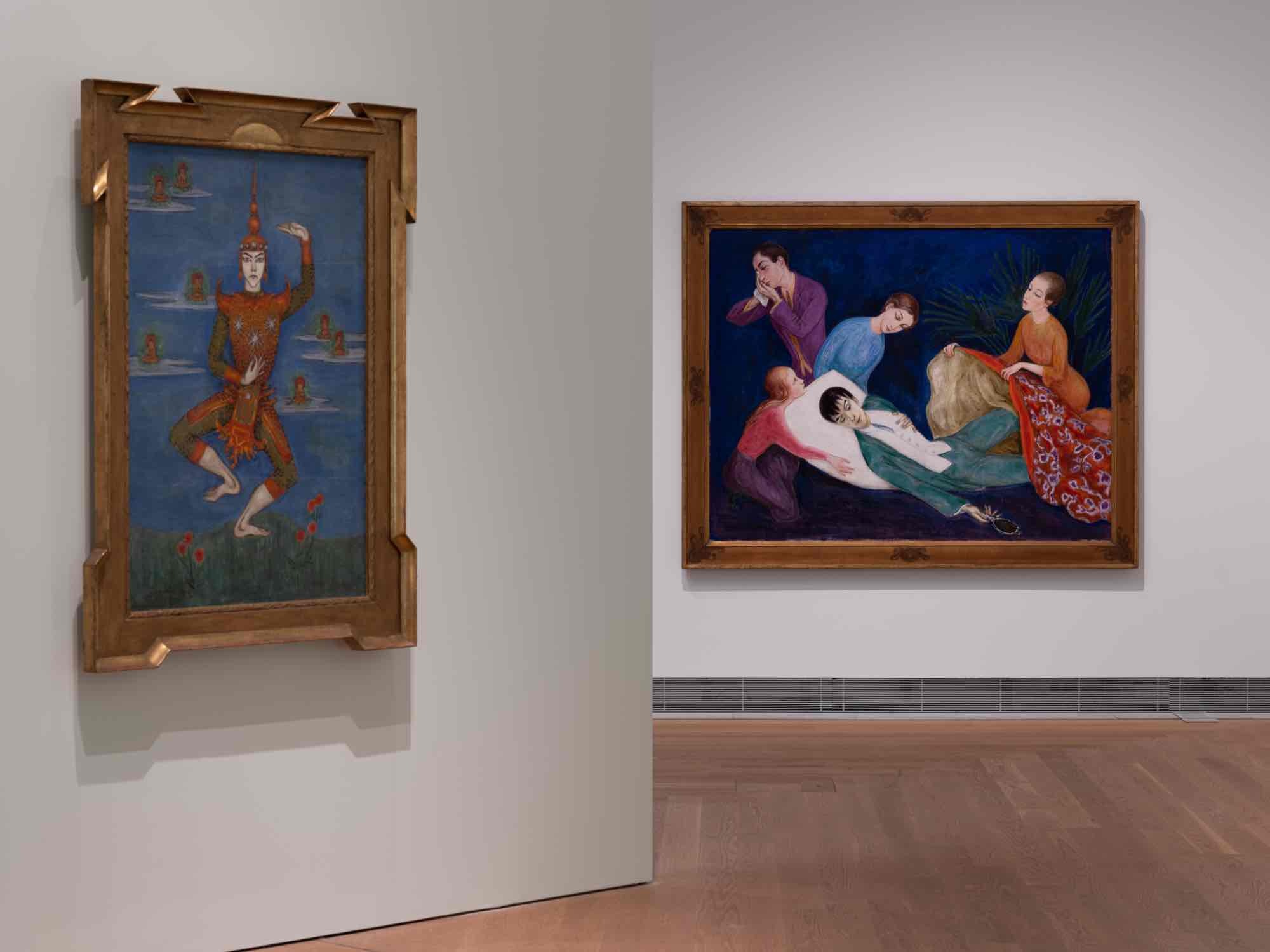
Jean Börlin i Siamesisk Dans (1919) and Den döende dandyn (1918). Nils Dardel. Photo: Mattias Lindbäck/Moderna Museet

Installation view. In center from the left: Gammal flicka (1944-1945) and Mormor och Puck (ca 1945). Siri Derkert. Photo: Mattias Lindbäck/Moderna Museet

Installation view. In center from the left: The Speaker (ca 1920) and The Scene (ca 1925). Gösta-Adrian Nilsson (GAN). Photo: Mattias Lindbäck/Moderna Museet

Carola Grahn, Horizon of Me(aning), 2021 Installation, birchwood.
Photo: Tobias Fischer/Moderna Museet
Photo: Tobias Fischer/Moderna Museet
Curator: Matilda Olof-Ors
The exhibition Pink Sails highlights some of the imagery and styles that existed side by side in an era of major social change. Sweden was rapidly transforming from an agrarian society to an industrial nation – social reform and optimism about the future mixed with military armament and fears of an imminent world war. Pink Sails features selected works from the four first decades of the 20th century and the multifaceted field of art that is now known as Swedish modernism.
“Pink Sails – Swedish Modernism in the Moderna Museet Collection” is the second instalment in the Museum’s new themed presentations of its collection.
The curator Matilda Olof-Ors borrowed the title from Ragnar Sandberg’s twilight scene Pink Sails from 1934.In the exhibition, visitors will meet some 100 works by Anna Casparsson, Siri Derkert, Sven X-et Erixson, Isaac Grünewald, Sigrid Hjertén, Bror Hjorth, Hilding Linnqvist, Vera Nilsson, Ragnar Sandberg, Otte Sköld and many other artists.
A time of change
Diving into Moderna Museet’s collection, “Pink Sails” features highlights from 1900 to the 1940s. This was a time when radical social change, world wars and influences from major European cities, including Paris and Berlin, impacted deeply on art.
Many Swedish artists were exploring new styles to convey and reflect modern society. This is also evident in the portrayals of landscapes, with new industries and motifs from the fast-growing cities and their outskirts. The city limits formed borderland where the old rural life merged with the new urban culture.
The exhibition begins with Sven X-et Erixson’s “The Painter’s House” from 1942. In this large painting, nature is in full bloom, and the artist’s family is busy with everyday games and chores. But the peaceful, suburban idyll is threatened by three military planes in the sky.
Industrial society vs nature
The idea of nature as an endless resource for exploitation became more entrenched in the industrial era. The natural resources of northern Sweden were especially interesting, where rivers were harnessed for electricity and mining was mechanised, contributing significantly to Sweden’s rapid industrialisation. This perspective contrasted sharply with the Sami perception of nature as an animate, living being. People who had lived for generations in these now-desirable regions were forced to move, or witnessed how their homelands were suddenly ravaged and changed. As more and more people moved to the cities, nature became something that had to be sought, rather than part of everyday life, and the northern landscape held an allure to artists like Helmer Osslund.
Inspiration from dreams, feelings and memories
The new rational society that was evolving also prompted artists and writers to seek inspiration in the subconscious, in dreams and memories. They focused on the inner world, feelings and imagination, rather than external reality. Other artists looked to literature, folk tales and myths. Inspiration also came from the style of self-taught artists.
Artists who found their subject matter in vernacular settings and encounters could also reveal poetic undercurrents. The immediate surroundings were portrayed in lyrical images, as if to preserve the life that was threatened by the contemporary turmoil. Dreaming and fantasising about other worlds and past times became a way of coping with wartime isolation.
A century of contemporary perspectives
Nearly a century separates the early works in “Pink Sails” from Carola Grahn’s sculpture “Horizon of Me(aning)” from 2015/2023 in the exhibition – a horizon of birch firewood stacked while following the artist’s instructions to talk about mental health. The work was first performed in 2015, after several suicides in Sápmi, a region where life and livelihoods have changed radically. With a philosophy of life where nature is animate, firewood can be imagined to preserve people’s life stories.
“In the new exhibitions of works from the collection, Moderna Museet seeks to turn our attention to art history. Today, a century later, a war is going on in Europe; society is changing even faster and more extensively. Now, as before, we turn to nature’s resources to solve contemporary challenges,” says Matilda Olof-Ors.
More about the new collection exhibition programme
Moderna Museet has one of Europe’s finest collections of modern and contemporary art, comprising some 140,000 works.
The challenge for Moderna Museet is to make this art treasure available to the general public. Therefore, the collection is now being presented in thematic exhibitions that replace the previous chronological format, to explore different art historic narratives. In this way, visitors will be able to see so much more of the collection.
Together, the new exhibition programme will highlight art from 1900 to today, reflecting the whole range of the Moderna Museet collection.
The exhibition Pink Sails highlights some of the imagery and styles that existed side by side in an era of major social change. Sweden was rapidly transforming from an agrarian society to an industrial nation – social reform and optimism about the future mixed with military armament and fears of an imminent world war. Pink Sails features selected works from the four first decades of the 20th century and the multifaceted field of art that is now known as Swedish modernism.
“Pink Sails – Swedish Modernism in the Moderna Museet Collection” is the second instalment in the Museum’s new themed presentations of its collection.
The curator Matilda Olof-Ors borrowed the title from Ragnar Sandberg’s twilight scene Pink Sails from 1934.In the exhibition, visitors will meet some 100 works by Anna Casparsson, Siri Derkert, Sven X-et Erixson, Isaac Grünewald, Sigrid Hjertén, Bror Hjorth, Hilding Linnqvist, Vera Nilsson, Ragnar Sandberg, Otte Sköld and many other artists.
A time of change
Diving into Moderna Museet’s collection, “Pink Sails” features highlights from 1900 to the 1940s. This was a time when radical social change, world wars and influences from major European cities, including Paris and Berlin, impacted deeply on art.
Many Swedish artists were exploring new styles to convey and reflect modern society. This is also evident in the portrayals of landscapes, with new industries and motifs from the fast-growing cities and their outskirts. The city limits formed borderland where the old rural life merged with the new urban culture.
The exhibition begins with Sven X-et Erixson’s “The Painter’s House” from 1942. In this large painting, nature is in full bloom, and the artist’s family is busy with everyday games and chores. But the peaceful, suburban idyll is threatened by three military planes in the sky.
Industrial society vs nature
The idea of nature as an endless resource for exploitation became more entrenched in the industrial era. The natural resources of northern Sweden were especially interesting, where rivers were harnessed for electricity and mining was mechanised, contributing significantly to Sweden’s rapid industrialisation. This perspective contrasted sharply with the Sami perception of nature as an animate, living being. People who had lived for generations in these now-desirable regions were forced to move, or witnessed how their homelands were suddenly ravaged and changed. As more and more people moved to the cities, nature became something that had to be sought, rather than part of everyday life, and the northern landscape held an allure to artists like Helmer Osslund.
Inspiration from dreams, feelings and memories
The new rational society that was evolving also prompted artists and writers to seek inspiration in the subconscious, in dreams and memories. They focused on the inner world, feelings and imagination, rather than external reality. Other artists looked to literature, folk tales and myths. Inspiration also came from the style of self-taught artists.
Artists who found their subject matter in vernacular settings and encounters could also reveal poetic undercurrents. The immediate surroundings were portrayed in lyrical images, as if to preserve the life that was threatened by the contemporary turmoil. Dreaming and fantasising about other worlds and past times became a way of coping with wartime isolation.
A century of contemporary perspectives
Nearly a century separates the early works in “Pink Sails” from Carola Grahn’s sculpture “Horizon of Me(aning)” from 2015/2023 in the exhibition – a horizon of birch firewood stacked while following the artist’s instructions to talk about mental health. The work was first performed in 2015, after several suicides in Sápmi, a region where life and livelihoods have changed radically. With a philosophy of life where nature is animate, firewood can be imagined to preserve people’s life stories.
“In the new exhibitions of works from the collection, Moderna Museet seeks to turn our attention to art history. Today, a century later, a war is going on in Europe; society is changing even faster and more extensively. Now, as before, we turn to nature’s resources to solve contemporary challenges,” says Matilda Olof-Ors.
More about the new collection exhibition programme
Moderna Museet has one of Europe’s finest collections of modern and contemporary art, comprising some 140,000 works.
The challenge for Moderna Museet is to make this art treasure available to the general public. Therefore, the collection is now being presented in thematic exhibitions that replace the previous chronological format, to explore different art historic narratives. In this way, visitors will be able to see so much more of the collection.
Together, the new exhibition programme will highlight art from 1900 to today, reflecting the whole range of the Moderna Museet collection.

